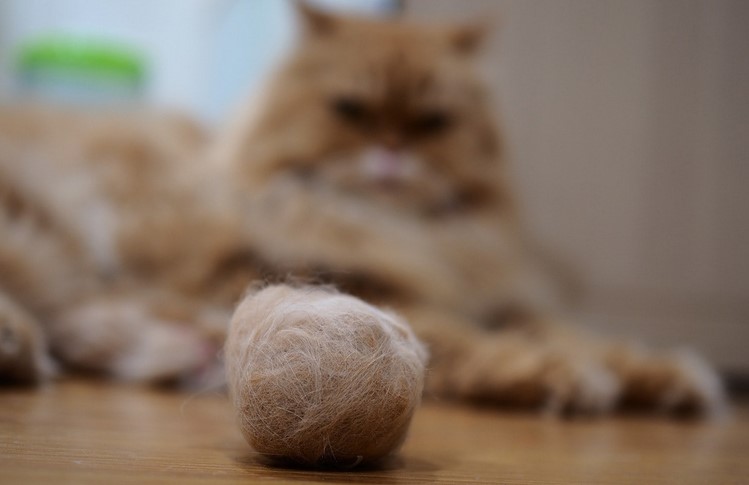If your cat has recently developed a hairball, it’s best to know what causes one. Read on to learn more about the causes and symptoms of cat hairballs. The best way to treat your cat is to call the vet, who can assess your cat’s health history and determine the best treatment. A veterinarian can provide you with treatment options, such as giving him/her a calming medicine or an oral medication. If you notice your cat vomiting or rubbing itself with a towel, this may be a sign of a hairball.
Hairballs can be disgusting, but they develop as a result of your cat’s grooming routine. They move around their skin and rub against surfaces like desks, window sills, or furniture. This helps them remove dirt and dead flakes of skin without them falling out of the fur. At the same time, loose hairs are also removed by this self-cleaning process.

Hairballs in cats
If you have ever noticed your cat having hairballs, you’re not alone. Millions of cats suffer from this common condition, and while there are numerous natural remedies, not all of them are effective. Fortunately, there are some easy solutions to help your kitty get rid of hairballs. One of the easiest solutions is to feed your cat a diet rich in fiber. Try to choose food high in cellulose, sugarcane fiber, and beet pulp, as they all have beneficial effects on the digestive system. You can also keep grooming to a minimum, and feed your cat less frequently to reduce hairballs.
Regular brushing is essential for your kitty’s health and can help reduce hairball production. Brushing will also remove loose fur, which can cause hairballs. Brushing your cat can help prevent hairballs by preventing excessive grooming, but excessive grooming may lead to health problems. Some products can help prevent hairballs by keeping your cat’s coat and undercoat clean. A cat brush that’s specifically designed for this purpose will remove loose hair from the top coat and dense undercoat.
What is a cat hairball?
A cat hairball is a collection of dead hair and digestive juices in the stomach. Cats naturally groom themselves by licking their fur and ingesting small bits of loose hair. The hairball develops from this buildup, and cats vomit it as a way to eliminate the buildup. Cats’ hairballs can range in size from one to five inches and contain bits of food that the cat may have swallowed.
Cats’ digestive tracts contain barbs that are backward-facing, which make it difficult to spit out anything that gets stuck on the tongue. This means that hair must pass through, which means that string or laces can become lodged in the cat’s stomach. Hairballs vary in size, but are usually cylindrical in shape and result from a narrow esophagus. The symptoms of a cat hairball are usually accompanied by a loud retching or hacking sound.
A hairball can be a serious concern. The cylinder-shaped hairball can be difficult for people to spot and is often mistaken for feces. While most cat owners do not think of hairballs as serious health issues, they can be a symptom of another condition. Moreover, excessive vomiting and loss of appetite are signs of a cat hairball. For this reason, it’s important to visit a veterinarian as soon as possible.
Symptoms of Hairballs in Cats
Symptoms of hairball in cats include vomit containing hair, food, and fluid. These vomitus symptoms must be addressed immediately. Cats with hairballs may also be suffering from other medical conditions, and therefore, a trip to the veterinarian is essential. Besides examining your cat, your veterinarian will run a series of tests to determine the cause of your cat’s condition. If you notice that your cat is vomiting excessively, consult a veterinarian to help determine the cause.
Fever and loss of appetite are also common signs of a hairball in your cat. Seeing your veterinarian as soon as possible is the best option for treating hairball symptoms. Your cat may also be vomiting or experiencing diarrhea. This means that the hairball may have caused a blockage that has rendered its pet weak. Your veterinarian will examine your cat and give you the right medication. Your cat may have an allergic reaction or a skin condition.

What Causes Hairballs in Cats?
If you notice your cat having hairballs, there are a few things you can do to help prevent them. First of all, brush your cat regularly and make sure they have clean water to drink at all times. If you notice hairballs, you may also need to try giving them a hairball gel or cat treats. You may also want to consult a vet about any underlying medical conditions your cat may have.
While cats with hairballs do tend to have more of them, they do not always vomit them out. Some cats have more hair than others and over-grooming is one common cause. Other reasons can include skin disease and ectoparasites. Digestive problems can also increase the risk of hairballs. GI motility disorders and chronic vomiting are both causes of increased hairball production.
Although hairballs are harmless and common among cats, if your pet is having more than a couple per month, it is important to consult with a veterinarian. Several factors can contribute to hairballs in your cat, including their health, diet, and age. Some cats may experience hairballs a couple of times a month, while others may have them multiple times a day. Cats with frequent hairballs may need to be taken to the vet for further evaluation.
How often do cats have hairballs?
Unlike humans, cats produce hairballs when they groom themselves. The frequency and size of these hairballs vary by breed, and the amount of time spent grooming can also affect the number of hairballs produced. Long-haired cats are more likely to produce hairballs than short-haired ones, so you should be aware of this fact. If you notice your cat having an excessive number of hairballs, visit your veterinarian to determine the exact cause.
While cats produce hairballs once or twice a week, many veterinarians view the occasional hairball as normal. However, cats with multiple hairballs may be suffering from a gastrointestinal condition. In these cases, veterinarians will recommend an examination. Cats should not have hairballs on a daily basis. If your cat is producing hairballs more than three times per week, see a veterinarian right away.
Hairballs are common in both cats and humans. They can range from an inch to five inches in diameter and are commonly caused by excess hair in the stomach. Hairballs may be dark or light, depending on the breed and the type of cat food the cat eats. Unlike human hairballs, however, cat hairballs are harmless unless they extend into the colon, which can lead to serious health problems.
Are cat hairballs normal?
A frequent and excessive supply of hairballs in your cat may be a sign of a more serious underlying health problem. While an occasional hairball is not a cause for concern, excessive retching may be indicative of asthma or an imbalance in the cat’s gut microbiome. In such cases, you should consult your veterinarian. The most important step is to rule out any underlying causes, including parasites or a skin disease.
Most cats will produce a few hairballs each month. Long-haired cats tend to produce more hairballs, and excessive grooming can contribute to more frequent episodes. But even if your cat only produces a few hairballs a week, it is worth taking it to the vet. Hairballs can indicate other health problems, including inflammatory bowel disease or intestinal cancer. The more hair your cat swallows during grooming, the greater its risk of developing a hairball.
The number of hairballs varies between cats and coat length. Long-haired cats have longer hair than short-haired cats, which makes them more prone to a hack attack. Hairballs are more common in spring than in winter, but healthy cats will typically have one or two a year. However, if your cat is constantly putting up with hairballs, a visit to the veterinarian is recommended.
Which cats produce more hairballs?
Cats naturally shed some hair. While many breeds produce hairballs on occasion, some types are more prone to the problem. Longhaired breeds produce more hairballs than shorthaired ones, primarily because of the length of their fur. Longhaired cats can be more susceptible to hairballs due to their excessive shedding, as their long hair tangles with dead hair and forms a ball. Longhaired cats also tend to shed more, which can lead to more hairballs around the house.
Longhaired cats tend to have hairballs more often than shorthaired cats, and longhaired cats are twice as likely to have them. Luckily, if your cat does develop a hairball, the best thing to do is give them plenty of room to throw it up. A long-haired cat will typically wretch or gag several times before passing a hairball. While this may seem like a problem, it is a temporary issue.
Hairball treatment for cats
A common problem for cats, hairballs can cause blockages within the gastrointestinal tract, which can lead to serious health problems. Hairballs are normal for most cats, but if you notice your cat vomiting frequently or with increased odor, it may be time to seek a vet’s advice. If your cat is vomiting often, it’s important to rule out intestinal parasites, bacterial overgrowth, or GI lymphoma.
There are several ways to treat hairballs. Using a small amount of petroleum jelly on a paw of your cat can help it pass a hairball. You can repeat this process once or twice a week to prevent a hairball from occurring. The petroleum jelly works as a lubricant for the passage of hair and can help the hairball pass out in the right way.
To use this treatment, make sure that your cat has an appropriate diet.
While hairballs are generally harmless, they can block the cat’s digestive tract and even be fatal. Cats swallow hair as they groom, and while most hair passes through the gastrointestinal tract without any trouble, there are times when too much hair accumulates and becomes trapped inside the stomach. Hairballs may appear as a lump or ball, which a cat may vomit up. If your cat vomits up a hairball, it may be due to intestinal blockage.
Cats are fastidious animals who spend a great deal of time grooming themselves. Because they ingest a large amount of fur when they are grooming, they also ingest a lot of hair. This hair starts to accumulate at some point: when fact meets function (hair accumulates but is later swallowed or coughed up), an illness develops in the form of hairballs. These are unsightly and unpleasant for your cat but are very easy to treat. If you keep an eye on the behavior and eating habits of your feline friend, you will be able to identify symptoms early on so that any problems can be treated quickly. This can reduce the amount of time your cat suffers from symptoms and prevent future bouts in many cases.

